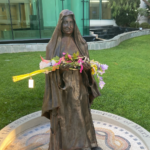Ephesus is known to Christian folk mainly from Paul’s visit in Acts 19 and the letter he later wrote to the church there. I don’t know how big the church was, but the city was huge.
And in the summer, it was hot. It still is.
 The upper city was home to offices and such for city officials and upper class folk, according to our guide, whose name is Kazim (“but you can call me K”). Ordinary people weren’t allowed, he said, though I suspect any number of service people would have been working there at any time. What looks like a small theater was used as a council house for city business. Next door was a sacred area dedicated to the Roman emperor and to Artemis, whose statue was found there.
The upper city was home to offices and such for city officials and upper class folk, according to our guide, whose name is Kazim (“but you can call me K”). Ordinary people weren’t allowed, he said, though I suspect any number of service people would have been working there at any time. What looks like a small theater was used as a council house for city business. Next door was a sacred area dedicated to the Roman emperor and to Artemis, whose statue was found there.
Just downhill a bit, a road sign featuring the entwined snakes of Asclepius indicated the presence of a large medical center, while a carving of a man with a sheep pointed the way to the commercial district.
Fancy terrace houses hugged the hillside across from the Temple of Hadrian, some of them featuring fancy mosaics, wall paintings, indoor plumbing, and heated floors. The hoi polloi used public bathrooms across the street.
The most impressive building in the city was not a temple, but a multi-story library that housed up to 12,000 scrolls and doubled as a tomb for Gaius Julius Celsus Plemanenus, the governor of Asia. Built by his son, Galius Julius Aquilla, it was reportedly the third-largest library in the ancient world, behind Alexandria and Pergamum. Four women symbolic of wisdom (Sophia), valor (Arete), intelligence (Ennoia), and knowledge (Episteme) adorned the facade, which is architecturaly designed to produce an optical illusion: the outside columns are slightly shorter than the ones in the middle, making it look larger. I loved it.
A famed arena in Ephesus could reportedly hold 25,000 people. It was there, according to Acts 19, that angry silversmiths dragged some of Paul’s companions and started a near-riot, shouting “Great is Artemis (Diana) of the Ephesians!”
 The arena stood at the end of a road leading directly from the city a harbor, which was at the end of a narrow inlet from the Aegean Sea. Unfortunately, the harbor silted in over the years, making the site less suited for commerce. The city entered a period of decline, and was eventually abandoned. Ephesus today is six miles from the sea, and inhabited only by tourists and cats.
The arena stood at the end of a road leading directly from the city a harbor, which was at the end of a narrow inlet from the Aegean Sea. Unfortunately, the harbor silted in over the years, making the site less suited for commerce. The city entered a period of decline, and was eventually abandoned. Ephesus today is six miles from the sea, and inhabited only by tourists and cats.
 In nearby Celchik, the Basilica of St. John was one of the largest basilicas of the ancient world. Built in the sixth century by the Emperor Justinian, it featured six domes over a large cruciform floor plan. Nothing is left of the domes, but my favorite part has survived: a real live walk in-walk out baptistery. Who would have thought?
In nearby Celchik, the Basilica of St. John was one of the largest basilicas of the ancient world. Built in the sixth century by the Emperor Justinian, it featured six domes over a large cruciform floor plan. Nothing is left of the domes, but my favorite part has survived: a real live walk in-walk out baptistery. Who would have thought?
We spent two hours at a place said to be run by the government as a training school for making Turkish carpets, having lunch, getting free drinks, and having our arms gently twisted to lay out $25,000 for a carpet large enough to fit under the dining room table. It was beautiful, but … well, you know. My biggest disappointment was that hours spent there meant no time to shop for a genuine fake watch outside the upper gate of Ephesus, but I’m keeping my eyes open for a genuine fake Turkish carpet.









